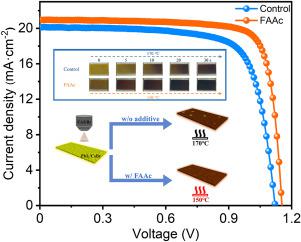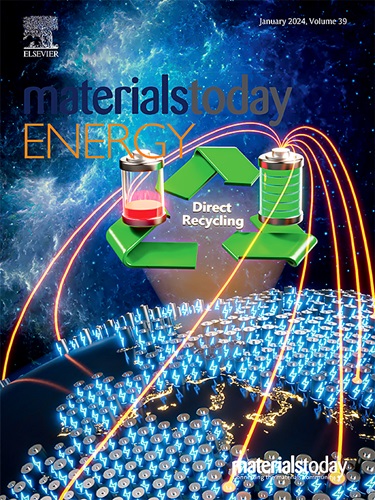基于低温法的宽带隙光伏太阳能电池蒸发/喷涂技术
IF 8.6
2区 材料科学
Q1 CHEMISTRY, PHYSICAL
引用次数: 0
摘要
多年来对基于过氧化物太阳能电池(PSC)的串联器件和单结器件的研究表明,低退火温度有利于提高器件性能。在这项研究中,假卤离子工程在蒸发/喷涂方法中效果良好。根据我们的研究,加入醋酸甲脒 (FAAc) 可以有效地将退火温度从 170 °C 降低到 150 °C,加速过氧化物薄膜的成熟过程,并扩大退火窗口。因此,可获得具有均匀结晶和低残余应力的过氧化物薄膜,从而延长电荷载流子寿命,提高光致发光量子产率(PLQY),降低乌巴赫能。通过蒸发/喷涂方法制备的相应 PSCs 的功率转换效率(PCE)达到了惊人的 19.46%,这是该方法制备的宽带隙(WBG)PSCs 中效率最高的。未封装器件表现出令人满意的稳定性,在 60 °C 下经过 600 小时热老化后,其 PCE 仍保持初始 PCE 的 80%;在 25 °C 下经过 1500 小时 50%湿度老化后,其 PCE 仍保持初始 PCE 的 90%。本文章由计算机程序翻译,如有差异,请以英文原文为准。

Low temperature method-based evaporation/spray-coating technology for wide bandgap perovskite solar cells
Years of working on perovskite solar cells (PSCs)-based tandem devices and single-junction devices have approved that low annealing temperatures can be beneficial for improving device performances. In this study, pseudo-halogen ion engineering works well in the evaporation/spray-coating method. According to our research, it is has been proven that the addition of formamidine acetate (FAAc) can effectively reduce the annealing temperature from 170 °C to 150 °C, accelerate the maturation process of the perovskite films, and broaden the annealing window. As a result, a perovskite film with homogeneous crystallization and low residual stress is achieved, leading to extended charge carrier lifetimes, elevated photoluminescence quantum yields (PLQY), reduced Urbach energies. The corresponding PSCs were prepared through evaporation/spray-coating method achieves an impressive power conversion efficiency (PCE) of 19.46%, which is the highest efficiency among wide-bandgap (WBG) PSCs fabricated by this method. And the unencapsulated devices exhibit satisfactory stability, retaining 80% of the initial PCE after 600 h of thermal aging at 60 °C and retaining 90% of the initial PCE after 1500 h of 50% humidity aging at 25 °C, respectively.
求助全文
通过发布文献求助,成功后即可免费获取论文全文。
去求助
来源期刊

Materials Today Energy
Materials Science-Materials Science (miscellaneous)
CiteScore
15.10
自引率
7.50%
发文量
291
审稿时长
15 days
期刊介绍:
Materials Today Energy is a multi-disciplinary, rapid-publication journal focused on all aspects of materials for energy.
Materials Today Energy provides a forum for the discussion of high quality research that is helping define the inclusive, growing field of energy materials.
Part of the Materials Today family, Materials Today Energy offers authors rigorous peer review, rapid decisions, and high visibility. The editors welcome comprehensive articles, short communications and reviews on both theoretical and experimental work in relation to energy harvesting, conversion, storage and distribution, on topics including but not limited to:
-Solar energy conversion
-Hydrogen generation
-Photocatalysis
-Thermoelectric materials and devices
-Materials for nuclear energy applications
-Materials for Energy Storage
-Environment protection
-Sustainable and green materials
 求助内容:
求助内容: 应助结果提醒方式:
应助结果提醒方式:


